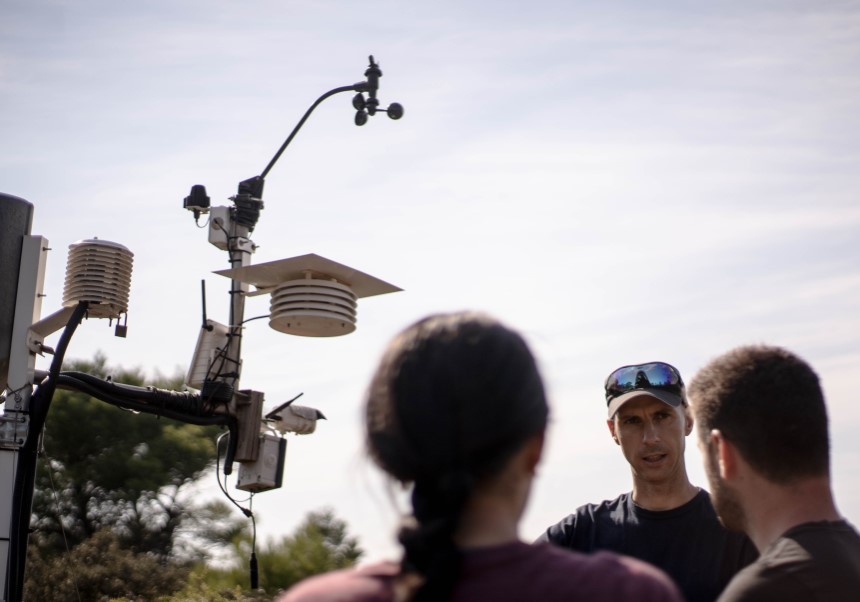
The Desertification Research Centre (CIDE) publishes the first work that quantifies the real impact of anemometer changes in an AEMET meteorological observatory
Advances in wind speed measurement could benefit sensor manufacturing, wind energy prospecting or studies on wind and its relationship with climate change
One of the main limitations in the study of climate change is the availability of quality data over time. This is also the case for wind speed, whose data depend on the proper functioning of measurement sensors, in particular anemometers. These instruments deteriorate and are replaced by others of better precision, which introduces an artificial error that alters the quantification of wind changes. This is what a team from the Desertification Research Centre (CIDE), a joint center of the Spanish National Research Council (CSIC), the University of Valencia (UV) and the Generalitat Valenciana, is trying to quantify and correct, having just published the first study that quantifies these errors from an official meteorological observatory.
This is the Climatoc-Lab of the CIDE, which leads a pioneering research on the quantification of the errors introduced by anemometer changes in the climatic series of wind speed. In addition, it applies corrections to make wind measurements robust over time, eliminating the artificial noise introduced by measurement errors. The article, published in July in the journal Atmospheric Research and in which researchers from the Interdisciplinary Thematic Platform Climate and Climate Services of the CSIC have participated, shows a real case study of the impact of these changes in the historical wind speed series of the official meteorological observatory of San Sebastian - Igueldo, under the State Meteorological Agency (AEMET).
For the head of the study, César Azorín, a researcher member of CSIC's PTI Clima, "the novelty of this study is the quantification of the impact of anemometer changes on wind speed measurements from a real meteorological observatory. Previous studies had carried out field and wind tunnel experiments under predefined conditions". Thus, the CIDE team measured three factors: the change in the type of anemometer (SEAC model versus THIES); change in the height of its installation; and the age of both models.
"The results show a significant impact of these changes on the wind speed measurement, whose errors were corrected to correctly estimate whether changes in surface winds have occurred," reveals César Azorín. Specifically, the biases in the measurements of mean wind speed and maximum gusts due to the performance of the more modern sensor, THIES, with respect to the old SEAC, represent an increase of about 4-5% with respect to the annual averages, according to the study data.
Applications
These errors also influence estimates of other processes where wind speed plays a fundamental role, such as evapotranspiration and water resource availability, and wind energy, among others. But the applications are manifold, from the design and manufacture of wind sensors to the use of these sensors in areas such as wind energy prospecting or in civil engineering, since correctly measuring wind load is a decisive factor in the construction of the structure, components and cladding of buildings.
"Climate science bases its research on data from different sources, mainly from two: data observed in Earth observation systems such as weather stations or satellites, and data simulated from numerical models," argues the CSIC researcher. "Although advances in modeling are evident in recent decades, the data observed at weather stations represent reality and are the main basis for quantifying past climate changes. Therefore, the quantification of errors in meteorological observation and the improvement of the quality of wind climate series are key to correctly estimate wind speed changes in the last decades".
International comparative study
National meteorological services around the world and climate assessment groups will benefit from these findings, according to César Azorín, "since errors in wind speed and maximum gust measurements can be minimized by implementing better observation protocols". Currently, the Climatoc-Lab of CIDE is developing in collaboration with the National Institute of Water and Atmospheric Research of New Zealand (NIWA) a unique experiment in the world where several anemometers in widespread use by the different National Meteorological Services are compared to quantify the deviations and differences in wind measurement between them.
Reference:
Cesar Azorin-Molina, Amir Ali Safaei Pirooz, Shalenys Bedoya-Valestt, Eduardo Utrabo-Carazo, Miguel Andres-Martin, Cheng Shen, Lorenzo Minola, Jose A. Guijarro, Enric Aguilar, Manola Brunet, Richard G.J. Flay, Sergio M. Vicente-Serrano, Tim R. McVicar, Deliang Chen, Biases in wind speed measurements due to anemometer changes, Atmospheric Research, Volume 289, 2023, 106771. DOI: https://doi.org/10.1016/j.atmosres.2023.106771
CIDE Communication









